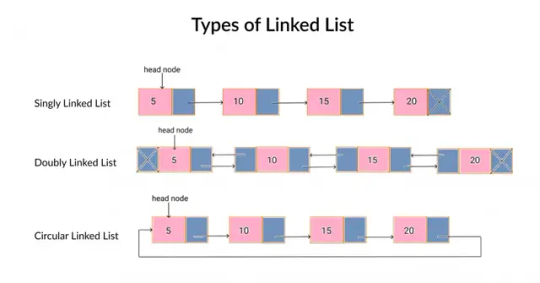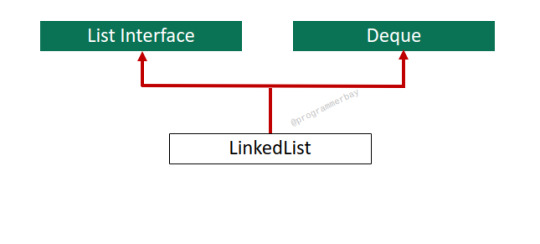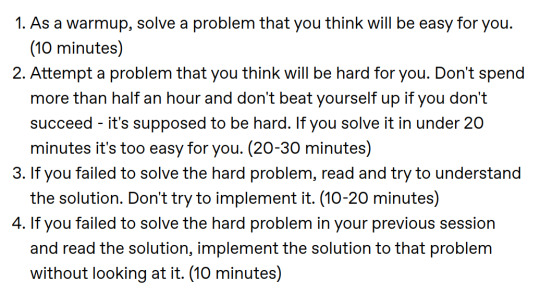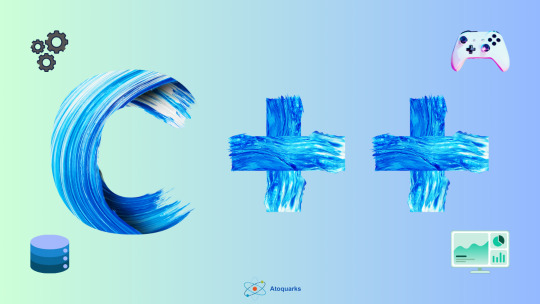#deletion in doubly linked list
Explore tagged Tumblr posts
Text
I decided to sit my ass down and learn what a linked list is finally 🫣

It was shockingly uncomplicated 💀
I ended up implementing my own doubly linked list for integers in C and it was super helpful for understanding the data structure as well as a nice reminder about using pointers and manual memory allocation.
Of course, I wrote a few functions to do the following:
- Add to start of list
- Add to end of list
- Remove from start of list
- Remove from end of list
- Delete specific value
Of course, there's much more I can do, but I'm happy with where I'm at so far. Definitely a good exercise to get back into things before uni starts properly 😁
75 notes
·
View notes
Text
Linked List in Python
A linked list is a dynamic data structure used to store elements in a linear order, where each element (called a node) points to the next. Unlike Python lists that use contiguous memory, linked lists offer flexibility in memory allocation, making them ideal for situations where the size of the data isn’t fixed or changes frequently.

In Python, linked lists aren’t built-in but can be implemented using classes. Each node contains two parts: the data and a reference to the next node. The list is managed using a class that tracks the starting node, known as the head.
Node Structure: Contains data and next (pointer to the next node).
Types:
Singly Linked List
Doubly Linked List
Circular Linked List
Operations: Insertion, deletion, and traversal.
Advantages:
Dynamic size
Efficient insertions/deletions
Disadvantages:
Slower access (no random indexing)
Extra memory for pointers
Want to master linked lists and other data structures in Python? PrepInsta has you covered with beginner-friendly explanations and practice problems.
Explore Linked Lists with PrepInsta
2 notes
·
View notes
Text
CS3353 Programming assignment 1
Implement insertion, deletion and search for a doubly-linked list as defined in class. The input has a list of pairs of an integer key followed with an operation delimited by spaces. An example of input file contents would look like 1.in 3.in 5.in 3.del 2.in 1.sch. There are a total of 3 operations in the input file given: in operation: Insertions to the doubly-linked list are to be performed…
0 notes
Text
Mastering Data Structures Using Python: A Complete Guide
When learning programming, mastering Data Structures Using Python is one of the most critical milestones. Python, known for its simplicity and versatility, is a perfect language to delve into data structures, which form the backbone of efficient algorithms. In this blog, we’ll explore the essential data structures in Python, how to use them, and why they’re so vital in programming.
Why Learn Data Structures Using Python?
1. Simplifies Complex Operations
Python's built-in libraries and clean syntax make implementing data structures intuitive. Whether you’re manipulating arrays or designing trees, Python minimizes complexity.
2. High Demand for Python Programmers
The demand for professionals with expertise in Python for data structures is skyrocketing, especially in fields like data science, artificial intelligence, and software engineering.
3. A Foundation for Problem-Solving
Understanding data structures like lists, stacks, queues, and trees equips you to solve complex computational problems efficiently.
What Are Data Structures?
At their core, data structures are ways of organizing and storing data to perform operations like retrieval, insertion, and deletion efficiently. There are two main types:
Linear Data Structures: Data is stored sequentially (e.g., arrays, linked lists).
Non-Linear Data Structures: Data is stored hierarchically (e.g., trees, graphs).
Python, with its versatile libraries, offers tools to implement both types seamlessly.
Essential Data Structures in Python
1. Lists
One of Python's most versatile data structures, lists are dynamic arrays that can store heterogeneous data types.
Example:
python
Copy code
# Creating a list
fruits = ["apple", "banana", "cherry"]
print(fruits[1]) # Output: banana
Features of Lists:
Mutable (elements can be changed).
Supports slicing and iteration.
Used extensively in Python programming for simple data organization.
2. Tuples
Tuples are immutable sequences, often used for fixed collections of items.
Example:
python
Copy code
# Creating a tuple
coordinates = (10, 20)
print(coordinates[0]) # Output: 10
Key Benefits:
Faster than lists due to immutability.
Commonly used in scenarios where data integrity is crucial.
3. Dictionaries
Dictionaries in Python implement hash maps and are perfect for key-value storage.
Example:
python
Copy code
# Creating a dictionary
student = {"name": "John", "age": 22}
print(student["name"]) # Output: John
Why Use Dictionaries?
Quick lookups.
Ideal for scenarios like counting occurrences, storing configurations, etc.
4. Sets
Sets are unordered collections of unique elements, useful for removing duplicates or performing mathematical set operations.
Example:
python
Copy code
# Using sets
numbers = {1, 2, 3, 4, 4}
print(numbers) # Output: {1, 2, 3, 4}
Applications:
Used in tasks requiring unique data points, such as intersection or union operations.
Advanced Data Structures in Python
1. Stacks
Stacks are linear data structures following the LIFO (Last In, First Out) principle.
Implementation:
python
Copy code
stack = []
stack.append(10)
stack.append(20)
print(stack.pop()) # Output: 20
Use Cases:
Undo operations in text editors.
Browser backtracking functionality.
2. Queues
Queues follow the FIFO (First In, First Out) principle and are used for tasks requiring sequential processing.
Implementation:
python
Copy code
from collections import deque
queue = deque()
queue.append(1)
queue.append(2)
print(queue.popleft()) # Output: 1
Applications:
Customer service simulations.
Process scheduling in operating systems.
3. Linked Lists
Unlike arrays, linked lists store data in nodes connected via pointers.
Types:
Singly Linked Lists
Doubly Linked Lists
Example:
python
Copy code
class Node:
def __init__(self, data):
self.data = data
self.next = None
# Creating nodes
node1 = Node(10)
node2 = Node(20)
node1.next = node2
Benefits:
Efficient insertion and deletion.
Commonly used in dynamic memory allocation.
4. Trees
Trees are hierarchical structures used to represent relationships.
Types:
Binary Trees
Binary Search Trees
Heaps
Example:
python
Copy code
class TreeNode:
def __init__(self, data):
self.data = data
self.left = None
self.right = None
Applications:
Databases.
Routing algorithms.
5. Graphs
Graphs consist of nodes (vertices) connected by edges.
Representation:
Adjacency List
Adjacency Matrix
Example:
python
Copy code
graph = {
"A": ["B", "C"],
"B": ["A", "D"],
"C": ["A", "D"],
"D": ["B", "C"]
}
Applications:
Social networks.
Navigation systems.
Why Python Stands Out for Data Structures
1. Built-In Libraries
Python simplifies data structure implementation with libraries like collections and heapq.
2. Readable Syntax
Beginners and experts alike find Python's syntax intuitive, making learning data structures using Python easier.
3. Versatility
From simple algorithms to complex applications, Python adapts to all.
Common Challenges and How to Overcome Them
1. Understanding Concepts
Some learners struggle with abstract concepts like recursion or tree traversal. Watching tutorial videos or practicing coding challenges can help.
2. Memory Management
Efficient use of memory is critical, especially for large-scale data. Python's garbage collection minimizes these issues.
3. Debugging
Using tools like Python’s pdb debugger helps troubleshoot problems effectively.
0 notes
Text
Solved CPSC 131, Data Structures Homework 2: Sequence Containers
Learning Goals: • Familiarization with arrays, extendable vectors, and doubly and singly linked lists • Understanding the sequence container’s insertion, deletion, traversal, and search concepts. • Reinforce the similarities and differences between the sequence data structures and their interfaces. • Analyze and understand the differences in the sequence container’s complexity for some of the…
0 notes
Text
Essential Algorithms and Data Structures for Competitive Programming
Competitive programming is a thrilling and intellectually stimulating field that challenges participants to solve complex problems efficiently and effectively. At its core, competitive programming revolves around algorithms and data structures—tools that help you tackle problems with precision and speed. If you're preparing for a competitive programming contest or just want to enhance your problem-solving skills, understanding essential algorithms and data structures is crucial. In this blog, we’ll walk through some of the most important ones you should be familiar with.
1. Arrays and Strings
Arrays are fundamental data structures that store elements in a contiguous block of memory. They allow for efficient access to elements via indexing and are often the first data structure you encounter in competitive programming.
Operations: Basic operations include traversal, insertion, deletion, and searching. Understanding how to manipulate arrays efficiently can help solve a wide range of problems.
Strings are arrays of characters and are often used to solve problems involving text processing. Basic string operations like concatenation, substring search, and pattern matching are essential.
2. Linked Lists
A linked list is a data structure where elements (nodes) are stored in separate memory locations and linked together using pointers. There are several types of linked lists:
Singly Linked List: Each node points to the next node.
Doubly Linked List: Each node points to both the next and previous nodes.
Circular Linked List: The last node points back to the first node.
Linked lists are useful when you need to frequently insert or delete elements as they allow for efficient manipulation of the data.
3. Stacks and Queues
Stacks and queues are abstract data types that operate on a last-in-first-out (LIFO) and first-in-first-out (FIFO) principle, respectively.
Stacks: Useful for problems involving backtracking or nested structures (e.g., parsing expressions).
Queues: Useful for problems involving scheduling or buffering (e.g., breadth-first search).
Both can be implemented using arrays or linked lists and are foundational for many algorithms.
4. Hashing
Hashing involves using a hash function to convert keys into indices in a hash table. This allows for efficient data retrieval and insertion.
Hash Tables: Hash tables provide average-case constant time complexity for search, insert, and delete operations.
Collisions: Handling collisions (when two keys hash to the same index) using techniques like chaining or open addressing is crucial for effective hashing.
5. Trees
Trees are hierarchical data structures with a root node and child nodes. They are used to represent hierarchical relationships and are key to many algorithms.
Binary Trees: Each node has at most two children. They are used in various applications such as binary search trees (BSTs), where the left child is less than the parent, and the right child is greater.
Binary Search Trees (BSTs): Useful for dynamic sets where elements need to be ordered. Operations like insertion, deletion, and search have an average-case time complexity of O(log n).
Balanced Trees: Trees like AVL trees and Red-Black trees maintain balance to ensure O(log n) time complexity for operations.
6. Heaps
A heap is a specialized tree-based data structure that satisfies the heap property:
Max-Heap: The value of each node is greater than or equal to the values of its children.
Min-Heap: The value of each node is less than or equal to the values of its children.
Heaps are used in algorithms like heap sort and are also crucial for implementing priority queues.
7. Graphs
Graphs represent relationships between entities using nodes (vertices) and edges. They are essential for solving problems involving networks, paths, and connectivity.
Graph Traversal: Algorithms like Breadth-First Search (BFS) and Depth-First Search (DFS) are used to explore nodes and edges in graphs.
Shortest Path: Algorithms such as Dijkstra’s and Floyd-Warshall help find the shortest path between nodes.
Minimum Spanning Tree: Algorithms like Kruskal’s and Prim’s are used to find the minimum spanning tree in a graph.
8. Dynamic Programming
Dynamic Programming (DP) is a method for solving problems by breaking them down into simpler subproblems and storing the results of these subproblems to avoid redundant computations.
Memoization: Storing results of subproblems to avoid recomputation.
Tabulation: Building a table of results iteratively, bottom-up.
DP is especially useful for optimization problems, such as finding the shortest path, longest common subsequence, or knapsack problem.
9. Greedy Algorithms
Greedy Algorithms make a series of choices, each of which looks best at the moment, with the hope that these local choices will lead to a global optimum.
Applications: Commonly used for problems like activity selection, Huffman coding, and coin change.
10. Graph Algorithms
Understanding graph algorithms is crucial for competitive programming:
Shortest Path Algorithms: Dijkstra’s Algorithm, Bellman-Ford Algorithm.
Minimum Spanning Tree Algorithms: Kruskal’s Algorithm, Prim’s Algorithm.
Network Flow Algorithms: Ford-Fulkerson Algorithm, Edmonds-Karp Algorithm.
Preparing for Competitive Programming: Summer Internship Program
If you're eager to dive deeper into these algorithms and data structures, participating in a summer internship program focused on Data Structures and Algorithms (DSA) can be incredibly beneficial. At our Summer Internship Program, we provide hands-on experience and mentorship to help you master these crucial skills. This program is designed for aspiring programmers who want to enhance their competitive programming abilities and prepare for real-world challenges.
What to Expect:
Hands-On Projects: Work on real-world problems and implement algorithms and data structures.
Mentorship: Receive guidance from experienced professionals in the field.
Workshops and Seminars: Participate in workshops that cover advanced topics and techniques.
Networking Opportunities: Connect with peers and industry experts to expand your professional network.
By participating in our DSA Internship, you’ll gain practical experience and insights that will significantly boost your competitive programming skills and prepare you for success in contests and future career opportunities.
In conclusion, mastering essential algorithms and data structures is key to excelling in competitive programming. By understanding and practicing these concepts, you can tackle complex problems with confidence and efficiency. Whether you’re just starting out or looking to sharpen your skills, focusing on these fundamentals will set you on the path to success.
Ready to take your skills to the next level? Join our Summer Internship Program and dive into the world of algorithms and data structures with expert guidance and hands-on experience. Your journey to becoming a competitive programming expert starts here!
0 notes
Text
The Ultimate Guide to Java Collection
Java libraries are indispensable tools that streamline development by providing pre-written code for common tasks. "The Ultimate Guide to Java Libraries" explores a myriad of libraries that enhance Java programming, from handling data structures to implementing complex algorithms.
A key feature covered is collections in Java, which offer efficient ways to manage groups of objects, improving code efficiency and readability.
TpointTech is a valuable resource for developers seeking in-depth tutorials and examples on using these libraries effectively. Leveraging these libraries can significantly reduce development time and improve application performance.
Overview of Java Collections
The Java Collections Framework includes interfaces, implementations, and algorithms. The core interfaces include Collection, List, Set, Queue, and Map, each serving different purposes.
Collection Interface:
The root interface of the framework, representing a group of objects known as elements. It is extended by List, Set, and Queue interfaces.
List Interface:
An ordered collection that allows duplicate elements. Common implementations are ArrayList, LinkedList, and Vector. Lists are ideal when you need to access elements by their index.
ArrayList: Resizable array implementation, offering constant-time positional access but slower for insertion and deletion.
LinkedList: Doubly-linked list implementation, providing efficient insertion and deletion but slower access time.
Vector: Synchronized version of ArrayList, rarely used due to performance overhead.
Set Interface:
A collection that does not allow duplicate elements. It models mathematical sets and provides implementations like HashSet, LinkedHashSet, and TreeSet.
HashSet: Uses a hash table for storage, offering constant-time performance for basic operations.
LinkedHashSet: Maintains insertion order, slightly slower than HashSet.
TreeSet: Implements the SortedSet interface, ensuring elements are in ascending order, based on their natural ordering or a specified comparator.
Queue Interface:
Designed for holding elements prior to processing, typically ordered in a FIFO (first-in-first-out) manner. Common implementations include LinkedList, PriorityQueue, and ArrayDeque.
PriorityQueue: Elements are ordered according to their natural ordering or a provided comparator, useful for creating priority-based tasks.
ArrayDeque: Resizable-array implementation of the Deque interface, providing efficient insertion and deletion from both ends.
Map Interface:
Represents a collection of key-value pairs, where each key maps to one value. Popular implementations are HashMap, LinkedHashMap, and TreeMap.
HashMap: Provides constant-time performance for basic operations, assuming a good hash function.
LinkedHashMap: Maintains a doubly-linked list of its entries, preserving the order of insertion.
TreeMap: Implements the SortedMap interface, ensuring keys are in ascending order.
Advantages of Java Collections Framework
Reduces Programming Effort: With a set of ready-made data structures and algorithms, JCF eliminates the need for developers to implement complex data structures from scratch.
Increases Program Speed and Quality: Standardized interfaces and optimized implementations ensure high performance and reliability.
Interoperability: Collections can be easily passed across APIs, reducing the complexity of integration.
Ease of Maintenance: Well-documented and widely-used classes make it easier for developers to maintain and enhance code.
Common Algorithms in JCF
Java Collections Framework includes various algorithms to perform routine tasks, such as sorting, searching, and shuffling. These algorithms are static methods in the Collections utility class.
Sorting: Collections.sort(List list), sorts the specified list into ascending order.
Shuffling: Collections.shuffle(List list), randomly permutes the elements in the list.
Searching: Collections.binarySearch(List> list, T key), performs binary search on a sorted list.
Conclusion
The Java Collections Framework is indispensable for any Java developer. It offers a standardized and efficient way to manage groups of objects, making code more robust and maintainable.
By leveraging the various interfaces and implementations, such as lists, sets, queues, and maps, developers can handle data structures effectively.
Understanding collections in Java, as detailed on resources like TpointTech, is crucial for building high-performance applications. Whether you're a beginner or an experienced developer, mastering Java collections will significantly enhance your programming capabilities.
0 notes
Text
You will program a Doubly Linked List class called `List`
In this assignment, you will program a Doubly Linked List class called `List` which parodies the [`std::list`](https://en.cppreference.com/w/cpp/container/list) class inherent to the Standard Template Library (STL) in C++. Topics: – Allocation (`new`) and Deallocation (`delete`) – Stack and Heap Memory – Bidirectional Iterators – Simplification of Random Access Iterators The difficulty of the…

View On WordPress
0 notes
Text
How to Ace Your DSA Interview, Even If You're a Newbie
Are you aiming to crack DSA interviews and land your dream job as a software engineer or developer? Look no further! This comprehensive guide will provide you with all the necessary tips and insights to ace your DSA interviews. We'll explore the important DSA topics to study, share valuable preparation tips, and even introduce you to Tutort Academy DSA courses to help you get started on your journey. So let's dive in!

Why is DSA Important?
Before we delve into the specifics of DSA interviews, let's first understand why data structures and algorithms are crucial for software development. DSA plays a vital role in optimizing software components, enabling efficient data storage and processing.
From logging into your Facebook account to finding the shortest route on Google Maps, DSA is at work in various applications we use every day. Mastering DSA allows you to solve complex problems, optimize code performance, and design efficient software systems.
Important DSA Topics to Study
To excel in DSA interviews, it's essential to have a strong foundation in key topics. Here are some important DSA topics you should study:
1. Arrays and Strings
Arrays and strings are fundamental data structures in programming. Understanding array manipulation, string operations, and common algorithms like sorting and searching is crucial for solving coding problems.
2. Linked Lists
Linked lists are linear data structures that consist of nodes linked together. It's important to understand concepts like singly linked lists, doubly linked lists, and circular linked lists, as well as operations like insertion, deletion, and traversal.
3. Stacks and Queues
Stacks and queues are abstract data types that follow specific orderings. Mastering concepts like LIFO (Last In, First Out) for stacks and FIFO (First In, First Out) for queues is essential. Additionally, learn about their applications in real-life scenarios.
4. Trees and Binary Trees
Trees are hierarchical data structures with nodes connected by edges. Understanding binary trees, binary search trees, and traversal algorithms like preorder, inorder, and postorder is crucial. Additionally, explore advanced concepts like AVL trees and red-black trees.
5. Graphs
Graphs are non-linear data structures consisting of nodes (vertices) and edges. Familiarize yourself with graph representations, traversal algorithms like BFS (Breadth-First Search) and DFS (Depth-First Search), and graph algorithms such as Dijkstra's algorithm and Kruskal's algorithm.
6. Sorting and Searching Algorithms
Understanding various sorting algorithms like bubble sort, selection sort, insertion sort, merge sort, and quicksort is essential. Additionally, familiarize yourself with searching algorithms like linear search, binary search, and hash-based searching.
7. Dynamic Programming
Dynamic programming involves breaking down a complex problem into smaller overlapping subproblems and solving them individually. Mastering this technique allows you to solve optimization problems efficiently.
These are just a few of the important DSA topics to study. It's crucial to have a solid understanding of these concepts and their applications to perform well in DSA interviews.
Tips to Follow While Preparing for DSA Interviews
Preparing for DSA interviews can be challenging, but with the right approach, you can maximize your chances of success. Here are some tips to keep in mind:
1. Understand the Fundamentals
Before diving into complex algorithms, ensure you have a strong grasp of the fundamentals. Familiarize yourself with basic data structures, common algorithms, and time and space complexities.
2. Practice Regularly
Consistent practice is key to mastering DSA. Solve a wide range of coding problems, participate in coding challenges, and implement algorithms from scratch. Leverage online coding platforms like LeetCode, HackerRank to practice and improve your problem-solving skills.
3. Analyze and Optimize
After solving a problem, analyze your solution and look for areas of improvement. Optimize your code for better time and space complexities. This demonstrates your ability to write efficient and scalable code.
4. Collaborate and Learn from Others
Engage with the coding community, join study groups, and participate in online forums. Collaborating with others allows you to learn different approaches, gain insights, and improve your problem-solving skills.
5. Mock Interviews and Feedback
Simulate real interview scenarios by participating in mock interviews. Seek feedback from experienced professionals or mentors who can provide valuable insights into your strengths and areas for improvement.
Following these tips will help you build a solid foundation in DSA and boost your confidence for interviews.
Conclusion
Mastering DSA is crucial for acing coding interviews and securing your dream job as a software engineer or developer. By studying important DSA topics, following effective preparation tips, and leveraging Tutort Academy's DSA courses, you'll be well-equipped to tackle DSA interviews with confidence. Remember to practice regularly, seek feedback, and stay curious.
Good luck on your DSA journey!
#programming#tutortacademy#tutort#DSA#data structures#data structures and algorithms#algorithm#interview preparation#interview tips
0 notes
Text
Java Collections Framework: A Comprehensive Guide

The Java Collection Framework (JCF) is one of the most important features of the Java programming language. It provides a unified framework for representing and managing collections, enabling developers to work more efficiently with data structures. Whether you are a beginner or an experienced Java developer, understanding the Java collection system is important. This comprehensive guide will delve into the basic design and implementation of the Java compilation system, highlighting its importance in modern Java programming. The basics of the Java collections framework At its core, the Java collections in Java with Examples consist of interfaces and classes that define collections. These collections can contain objects and provide functions such as insertion, deletion, and traversal. The main features of JCF include List, Set, and Map. Lists are ordered collections of objects, aggregates are unordered collections without duplicate objects, and maps are key-value pairs. Significant interactions with classes in the Java collection system List Interface: Lists in JCF are implemented by classes like ArrayList and LinkedList. ArrayList provides dynamic arrays, allowing quick access to elements, while LinkedList uses a doubly linked list internally, making insertion and deletion faster Set interfaces: Represent classes such as sets, HashSet and TreeSet, and do not allow duplicate elements. HashSet uses hashing techniques for fast access, while TreeSet maintains objects in sorted order, enabling efficient retrieval. Map Interface: Maps are represented by HashMap and TreeMap. HashMap uses hashing to store key-value pairs and provides a constant-time display for basic processing. TreeMap, on the other hand, maintains elements in a sorted tree structure, enabling operations in logarithmic time. Advantages of Java Collections Framework The concurrent Collections in Java Framework offers several benefits to developers: Re-usability: Pre-implemented classes and interfaces let developers focus on solving specific problems without worrying about downstream data structures Interactivity: Collections in JCF can store object by object, encouraging interactivity and allowing developers to work with multiple data types. Performance: The system is designed to be efficient. The algorithm is implemented in such a way that it is efficient in terms of time and memory consumption. Scalability: JCF supports scalability, allowing developers to handle large amounts of data without worrying about memory limitations. Frequent use of information in the Java collections system Data Storage and Retrieval: Lists, sets, and maps are widely used to store and retrieve data efficiently. Lists are suitable for sorted collections, aggregates for unique elements, and maps for key-value pairs. Algorithm Implementation: Java Collections Framework can be used to implement many algorithms such as search and sort. This simplifies the coding process and reduces the possibility of error. Concurrent control: Classes like ConcurrentHashMap and CopyOnWriteArrayList provide concurrent access to collections, ensuring thread safety in multi-threaded applications. Best practices for Java collections systems with examples 1. List Interface (ArrayList):import java.util.ArrayList;import java.util.List; public class ListExample {public static void main(String args) {List list = new ArrayList(); // Adding elements to the list list.add("Java"); list.add("Python"); list.add("C++"); // Accessing elements using index System.out.println("Element at index 1: " + list.get(1)); // Iterating through the list System.out.println("List elements:"); for (String language : list) { System.out.println(language); } // Removing an element list.remove("Python"); System.out.println("List after removing 'Python': " + list); } } 2. Set Interface (HashSet) import java.util.HashSet;import java.util.Set; public class SetExample {public static void main(String args) {Set set = new HashSet(); // Adding elements to the set set.add("Apple"); set.add("Banana"); set.add("Orange"); // Iterating through the set System.out.println("Set elements:"); for (String fruit : set) { System.out.println(fruit); } // Checking if an element exists System.out.println("Contains 'Apple': " + set.contains("Apple")); // Removing an element set.remove("Banana"); System.out.println("Set after removing 'Banana': " + set); } 3. Map Interface (HashMap):import java.util.HashMap;import java.util.Map; public class MapExample {public static void main(String args) {Map map = new HashMap(); // Adding key-value pairs to the map map.put("Java", 1); map.put("Python", 2); map.put("C++", 3); // Iterating through the map System.out.println("Map elements:"); for (Map.Entry entry : map.entrySet()) { System.out.println(entry.getKey() + ": " + entry.getValue()); } // Checking if a key exists System.out.println("Contains key 'Java': " + map.containsKey("Java")); // Removing a key-value pair map.remove("Python"); System.out.println("Map after removing 'Python': " + map); } Conclusion: In Java programming, the Java collections tutorial framework stands as the cornerstone of efficient data manipulation. Its versatile interfaces and classes empower developers to create complex applications, handling data structures with ease. Understanding the nuances of different types of collections, their functionality, and best practices is important for enabling Java developers aiming to build high-performance, scalable, and error-free applications Java collection concepts has been optimized to enable developers to unlock the full programming capabilities of Java Read the full article
0 notes
Text
Solved CPSC 131, Data Structures Homework 2: Sequence Containers
Learning Goals: • Familiarization with arrays, extendable vectors, and doubly and singly linked lists • Understanding the sequence container’s insertion, deletion, traversal, and search concepts. • Reinforce the similarities and differences between the sequence data structures and their interfaces. • Analyze and understand the differences in the sequence container’s complexity for some of the…
0 notes
Text
Tricky things with storing CLI history in a doubly-linked list while doing history sync:
If history entry deletes can be synced, a linked list node can become invalid while you're locally cycling through history - an index into an array/ring just points to whatever was moved into that spot after the delete (or a tombstone if you're avoiding O(n) data moves, which can be trivially checked for).
If history entries can be moved (for example, deduplication+sync yanks an older entry to the front), naive linked list node use can cause your history cycling to spontaneously mutate in weird ways: one moment you're ten+ entries deep in your history, the next you're back and the beginning.
For the most part, this doesn't matter.
I use sync more heavily and with rapid frequent movements between devices than most ever want to or would, and even I'm usually slower than the write->Syncthing->inotify->read that my devices do in the second it takes me to switch devices.
Moreover, when history sync falters and delays, what's the worst that happens? If it hits later, while you're trying to hit up/down arrow, the worst is that you cycle to a history item that's different than the one you were expecting ... and hit enter, because you mentally queued up something like "up up enter" based on what you remember of your command history.
So we could protect against the latter by just making sure that history syncs
0 notes
Text
LinkedList Class in Java with Program Example
LinkedList is child class of List and Queue interface. It owns the behaviour of Doubly Linked List and represents its underlying data structure . It is ideal to use when insertion or deletion are the frequent operations. In Linked List, elements are not stored in sequential manner,instead, each element in a Linked List is stored as a separate node, pointing to the previous and next elements in…

View On WordPress
0 notes
Note
as someone who basically exclusively interviews in c++... (as in: i once got an interview, got told it was for python on the interview.... then asked "can I do this in C++?")
its actually pretty nice! all of the caveats of using c++ in production (mostly) arent there if you're doing something completely self-contained, since you get to use all of C++11 (or even better, C++20)'s features, turning it basically into something like rust - just never touch new and delete and only use the STL and <memory> and you're good to go
also, python's "hashmap as default" realllly makes programming feel weird and the lack of typechecking in alot of places leads to (i find) programming where its easy to fuck up - the C++ compiler catches alot of what would be runtime errors in python
and of course, the C++ standard library has not just the kitchen sink but also the cutlery drawers, a wok or two for good measure and half a pantry of ingredients.
want quickselect? that's std::nth_element, want to use prefix sums? std::partial_sum. want to do permutations? well by god do we have the function for you (std::next_permutation)
every data structure i've wanted was implemented straight in C++ (with the one exception of a segtree, but i havent ever actually needed to use one) even (for some forsaken reason) a doubly-linked list, which I have actually used in a solution (you can insert at the end, then save the pointer to the element to remove it in O(1) time) without having to like actually code any of these damn things
so keep your head up! i complain about C++ but it isnt that bad - especially anything after 2011
hey congrats on reaching CM (? wanted to find the post where you mention that to confirm but tumblr search misbehaves). was curious as to how many problems you've solved on cf? I primarily picked it up cause ik it helped friends with interview stuff but I'm 2 months in stuck at ~1200 so wondering if I should be doing things differently. on one hand most problems <1400 are greedy or math so I worry an actual interview will be more "algorithmic" and I'll be unprepared (maybe leetcode is better in this regard?). on the other hand it's soo much easier to fantasise about being good at cp than actually practicing. so. anyway wondering if you had any advice on this? CM in one year does not sound like the journey of your average cf-er. congrats again. cheers!
Thank you!
(full disclosure: I've kind of fallen off with competitive programming - I haven't competed on codechef since January and codeforces/leetcode since April)
My solving totals, ratings, and number of contests are:
Leetcode: 824 problems, 2571 rating, 41 contests
Codeforces: 69 problems, 2000 rating, 14 contests
Codechef: 32 problems, 2046 rating, 4 contests
If you're looking for interview prep I would skip codeforces. Leetcode problems are closer to what you'll get in interviews, and their contests are much less of a time commitment. I also code in Rust on CF/CC and Python on Leetcode, and I much prefer to take interviews in Python.
If you snoop around a bit on reddit and the leetcode forums, you can often find lists of problems people have seen at a specific company's interviews to get a flavor of what you're up against. I really recommend this - the problem I struggled with the most in getting my current job was on one such list for my company and I wish I'd gone through the list. This was before I got really good, though.
I think my rapid growth was fueled by three things:
I did math competitions all the way through college that have a similar skillset
My college classes taught a lot of competitive programming concepts (I learned what a SegTree was in class!)
I had a period of 5 months between graduating and starting my job where I was unemployed and highly motivated, and I did a ton of grinding during that period. Most of my leetcode solves are from that time
If you're looking to improve but don't have a ton of time to burn, here's the regimen I recommended to another asker:

#competitive coding#i did not get the python job btw#but i did pass that interview#also for the record i practice leetcode by just applying to a bunch of jobs and then doing the practices they give me thats the only way to#be motivated to it for me#but yeah if you're thinking about using C++ for competitive programming my advice is know the standard library#inside and out and know how to use it you really wanna use the whole kitchen
24 notes
·
View notes
Photo

Video tutorial explains a C program to delete a node from doubly linked list. You will learn to delete first node, middle node as well as last node ffrom the doubly linked list. Doubly linked list is also known as two-way linked list. The C program is explained using step by step approach along with figures at each step. Entire source code is explained statement wise. In this tutorial, you will learn double link list deletion, delete the first node of doubly linked list and delete node at given position in doubly linked list. This online data structures and algorithms tutorial teaches, data structures in c, data structures interview questions and answers and data structures along with data structure programs. By the end of the vide you will be knowing, data structures and algorithms lectures, data structures tutorial videos and online data structures training. Complete coding is explained with figures at each step, you will understand, delete node at given position, data structures interview questions and previous pointer along with linked list using c. If you are looking for, delete a node from linked list, how to delete a node in doubly linked list and algorithm to delete a node from doubly linked list, then this video is for you. For code of deleting a node from doubly linked list, click the following link: http://bmharwani.com/deletefromdoubly.c For more video tutorials on data structures and algorithms, visit: https://www.youtube.com/watch?v=-XXsmBys2DQ&t=0s&list=PLuDr_vb2LpAxVWIk-po5nL5Ct2pHpndLR&index=6 To get notification for new videos, subscribe to my channel: https://youtube.com/c/bintuharwani To see more videos on different computer subjects, visit: http://bmharwani.com
#doubly linked list#delete a node from doubly linked list#double linked list#deletion in doubly linked list#time required to delete a node from doubly linked list#delete even nodes from doubly linked list#delete nth node from doubly linked list#delete middle node doubly linked list#write a function to delete a node from doubly linked list#delete a node from doubly linked list in c#delete middle node in doubly linked list#bintu harwani
2 notes
·
View notes
